Enka
| Enka | |
|---|---|
| Stylistic origins | Ryūkōka • Rōkyoku • Min'yō • Tango • Blues |
| Cultural origins | 1950s Japan. Name is derived from a music of the late 19th century. |
| Typical instruments | Vocal • Guitar • Bass guitar • Drum kit • Piano • Saxophone • Trumpet • Trombone • Shamisen • Shakuhachi |
| Mainstream popularity | High popularity in Japan in the late 1960s and early 1970s. |
Enka (演歌) is a Japanese popular music genre. Although considered to resemble traditional music stylistically, modern enka is a relatively recent musical form which arose in the context of such postwar expressions of modern Japanese nonmaterial nationalism as nihonjinron, while adopting a more traditional musical style than Japanese prewar popular ryūkōka music in the vocalism.[1]
The term "enka" was first used to refer to political texts set to music which were sung and distributed by opposition activists belonging to the Freedom and People's Rights Movement during the Meiji period (1868–1912) as a means of bypassing government curbs on speeches of political dissent – and in this sense the word is derived from "enzetsu no uta" (演説の歌), meaning "speech song".
Modern enka, as developed in the postwar era, is a form of popular ballad music. Some of the first modern enka singers were Hachiro Kasuga, Michiya Mihashi and Hideo Murata.[2] One theory holds that modern enka means "enjiru uta" (演じる歌), meaning "performance song".[3] The revival of enka in its modern form is said to date from 1969, when Keiko Fuji made her debut.
Musical style
One of earliest Japanese songs which used modern enka's mainstream scale called "Yonanuki Tan-Onkai" (ヨナ抜き短音階) or "Minor Scale without Four and Seven (re and sol)" was said to be Rentarō Taki's song "Kōjō no Tsuki", which was called "shōka" (唱歌) or "school song" in the Meiji Period.[4] There was not the seventh scale degree in the B minor song "Kōjō no Tsuki".[5] The scale was a modified version of "Yonanuki Chō-Onkai" (ヨナ抜き長音階) or "Major Scale without Four and Seven (fa and ti)", which came from one of Japanese previous scales, "Ryo Scale" (呂音階 Ryo Onkai).[6]
The music, based on the pentatonic scale, has some resemblance to blues,[7] which has been noted by Japanese-American enka singer Jero.[8] Enka lyrics are usually about the themes of love and loss, loneliness, enduring hardships, and persevering in the face of difficulties, even suicide or death. Although enka is a genre of kayōkyoku, enka is considered to be more expressive and emotional, though there is no clear consensus on the matter.[3][9]
Archetypal enka singers employ a style of melisma known as kobushi.[7][10] Kobushi occurs when the pitch of the singer's voice fluctuates irregularly within one scale degree; this compares with vibrato, which vibrates in a regular cycle.[11] The kobushi technique is not limited to enka, as you can hear in the Italian song "Santa Lucia".[11] In the late 1930s and early 1940s, the music of composer Masao Koga began to resemble Buddhist shomyo chanting possibly because his record label asked him for production of music.[12] Although Koga became a composer whose work is considered seminal for the creation of this genre, present enka is different from primary music of Koga because the singing styles of many postwar singers were different from the kobushi of Koga's musical note.[13] Modern enka singer Takeshi Kitayama said "I was even confused because his [Koga's] musical note was different from that of an old singer."[13][fn 1]
Enka suggests a traditional, idealized, or romanticized aspect of Japanese culture and attitudes. Enka singers, who are predominantly women, usually perform in a kimono or in evening dress. Male enka performers tend to wear formal dress, or in some performances, traditional Japanese attire. Nods to traditional Japanese music are common in enka. The melodies of enka are fundamentally Western harmonies, but its musical instruments include shakuhachi and shamisen, making it more Japanese.[14]
The genre called enka is also said to be an expediential classification for record labels as well as J-pop. For example, Harumi Miyako, who has been usually considered as an enka singer, said "I don't think that I sing enka" and "In fact, there was no term enka when I debuted."[15][fn 2]
History
19th century–1920s: Sōshi enka and violin enka
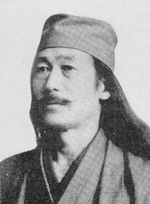
The political songs called enka in the Meiji period (1868–1912) are also called "Sōshi Enka" (壮士演歌) in distinction from modern enka. The street singers were called "enka-shi" (演歌師). The first enka song is said to be "Dynamite bushi" (ダイナマイト節).[16] The songs in this age includes Otojiro Kawakami's song "Oppekepe bushi".[17]
In the Taishō period (1912–1926), enka-shi began to use the violin and their songs were called "Violin Enka". One of enka-shi in that time was Toshio Sakurai (桜井敏雄), who had pupil Haruo Oka.[18]
In present Japan, Road Traffic Law regulates street performers. However, Japanese performers such as Utaji Fukuoka (福岡詩二) have still sung enka of the Taishō period.[19] When the Great Hanshin earthquake broke out in 1995, Soul Flower Mononoke Summit, a musical project of rock band Soul Flower Union, played sōshi enka to help encourage disaster victims.[20]
1920s–1940s: The era of ryūkōka
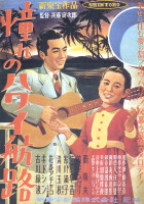
In the early Shōwa period around the late 1920s, record companies produced ryūkōka in place of street performers called "enka-shi".[21] On the other hand, enka-shi began to use guitar and they were dubbed "Nagashi" (流し).[3] Haruo Oka debuted with the 1939 song "Kokkyō no Haru" (国境の春 lit. "Spring at the Border") under the Japanese record label King Records.[22] However, the term "enka" became uncommon in the postwar years.[3]
Late 1940s–1954: Arrival of new singers
In the early postwar Japan, jazz became popular. Japanese female singer Hibari Misora released her debut song "Kappa boogie-woogie" under the Nippon Columbia in 1949 at the age of only 12. She was known for singing jazz songs in 1950s and 1960s.[23]
In 1948, Hachiro Kasuga got through the first contest of King Records. He entered the record label in 1949. In the King Records, Haruo Oka was Kasuga's senior. His debut single "Akai Lamp no Shū Ressha" (赤いランプの終列車 lit. "Last Train with Red Lamp") was released in 1952. Kabuki-style song "Otomi-san" (お富さん lit. "Miss Otomi") was originally made for Oka, but was sung by not Oka but Kasuga. In 1954, Kasuga's song "Otomi-san" hit Japanese popular music very much.[24] Kasuga took part in the NHK Kōhaku Uta Gassen for the first time with song "Otomi-san" in 1954.[25] Composer of the song, Masanobu Tokuchi, who born in Okinawa Island and grew up in Amami, became an important figure introducing the Ryukyu Islands' music into Japanese mainstream popular music.[26]
1955–1959: Early history of modern enka
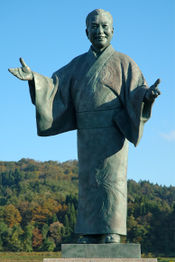
Although "Otomi-san" became popular, Hachiro Kasuga was not completely satisfied with the song "Otomi-san" and recorded the song "Wakare no Ippon-sugi" (別れの一本杉 lit. "Farewell One Cedar") composed by Toru Funamura.[2] The song was released in 1955 and was later regarded as a true enka song.[27] However, the song was influenced by tango music's rhythm because Funamura felt that tango appeared similar to enka in its local color.[27] "Wakare no Ippon-sugi" was later covered by various singers such as Michiya Mihashi, Hideo Murata, Keiko Fuji, Hibari Misora, Saburō Kitajima, Takashi Hosokawa and Hiroshi Itsuki.[28] Kasuga was later called the first enka singer.[2] However, Funamura's friend Kimio Takano, the lyricist of the song, died in 1956 at the age of 26.[27] Michiya Mihashi, who originally sang Japanese folk min'yō music and learned tsugaru-jamisen, released his debut single as a recording singer, "Sake no Nigasa yo", in 1954.[29] Mihashi made hit song "Onna Sendō Uta" in 1955.[29] Hibari Misora's music was turned into enka when she was not regarded as a teen idol anymore.[30]
Around the postwar period, rōkyoku (naniwa-bushi), which was famous during the war, became unpopular mainly because their speaking was considered too long. Enka, which became popular around that time, was said to be a short version of rōkyoku because several enka singers such as Hideo Murata and Haruo Minami were originally rōkyoku singers and enka has many themes in common with rōkyoku.[31] One of notable rōkyoku singers who had an influence on enka was Kumoemon Tochuken, whose pupil's pupil was Murata.[31] Minami debuted under the Teichiku Records in 1957 and Murata debuted under the Nippon Columbia in 1958. Murata covered the song "Jinsei Gekijō" (人生劇場 lit. "Drama of Life"), which was composed by Masao Koga.[13] Haruo Minami was known for wearing kimono, which was formerly an unusual style as a male singer.[32]
1960s: Commercial success
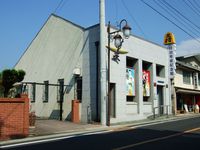
In the early 1960s, Japanese rockabilly affected by Elvis Presley began to gain popularity. Kyu Sakamoto, who came from Japanese rockabilly, joined Japanese popular music.[33] However, many Japanese music critics complained about rockabilly music and Hideo Murata's 1961 "pure Japanese style"-like song "Ōsho", composed by Toru Funamura, became a million-selling single in Japan.[34] When Kyu Sakamoto took part in the Kōhaku Uta Gassen for the first time with song "Ue o Muite Arukō" (aka "Sukiyaki") in 1961, Hideo Murata also made his debut with song "Ōsho" at the same show.[35]
Young enka singer Yukio Hashi debuted in 1960, Saburō Kitajima debuted in 1962, and Harumi Miyako debuted in 1964. Sachiko Kobayashi debuted with the 1964 single "Usotsuki Kamome" (ウソツキ鴎 lit. "Liar Common Gull") at the age of only 10. The most well-known and beloved performer of enka is Hibari Misora (1937–1989), who was known as the "Queen of Enka" and "Queen of Shōwa" for the period when she lived and was popular. Misora's song "Yawara", composed by Masao Koga, won the grand prix award at the 1965 Japan Record Award.[36] Masaru Matsuyama also made his debut in 1965, but was not able to achieve commercially success, and he changed his stage name to Hiroshi Itsuki in 1971.
Mina Aoe debuted with the single "Kōkotsu no Blues" (恍惚のブルース lit. "Ecstasy Blues") in 1966, pioneering the "enka-blues" genre.[37] Shinichi Mori debuted with the 1966 single "Onna no Tameiki" (女のためいき lit. "Woman's Sigh"). His 1969 song "Minatomachi Blues" (港町ブルース lit. "Port Town Blues") topped the Japanese Oricon single charts for five weeks and sold over one million copies.[38] Keiko Fuji debuted with the 1969 single "Shinjuku no Onna" (新宿の女 lit. "Woman in Shinjuku") at the age of 18. The term "enka", which had not been used in postwar era, was revived by her performance.[3]
1970s: Maintaining popularity

Keiko Fuji's 1970 song "Keiko no Yume wa Yoru Hiraku" won the mass popularity award of the 12th Japan Record Awards and the grand prix award of the first Japan Music Awards. In 1970, she took part in the 21st Kōhaku Uta Gassen by the song. Her 1970 album "Shinjuku no Onna/'Enka no Hoshi' Fuji Keiko no Subete" (新宿の女/"演歌の星" 藤圭子のすべて Woman in Shinjuku/'Star of Enka' All of Keiko Fuji) established a still-standing consecutive number-one record to top the Oricon charts for 20 "consecutive" weeks.[39]
The best-selling enka after the Oricon charts began in 1968 is Shiro Miya and Pinkara Trio's 1972 song "Onna no Michi". The song topped the Japanese Oricon single charts for 16 consecutive weeks and sold over 3.25 million copies, being the second best-selling single in Japan behind "Oyoge! Taiyaki-kun".
Hiroshi Itsuki's song "Yozora" won the grand prix award at the 15th Japan Record Awards in 1973. On the other hand, Shinichi Mori released single "Erimo Misaki" in 1974. Although the song was composed by non-enka musician Takuro Yoshida, "Erimo Misaki" won the grand prix award at the 16th Japan Record Awards of that year. Harumi Miyako's song "Kita no Yado kara" also won the grand prix award at the 18th Japan Record Awards in 1976. New enka singers, who debuted in 1970s, included Sayuri Ishikawa and Takashi Hosokawa. Ishikawa and Hosokawa were Michiya Mihashi's pupils.[29]
Masao Koga died in 1978, after he composed about five thousand songs.[13] Toru Funamura become self-employed in 1978, beginning live performances and returning to the original position for his old friend Kimio Takano.[27] Keiko Fuji announced her retirement in 1979 and went to the United States.[40]
1980s: Bitter struggle

Takashi Hosokawa's song "Kita Sakaba" won the grand prix award at the 24th Japan Record Awards in 1982. His song "Yagiri no Watashi" also won the grand prix award at the 25th Japan Record Awards in 1983. The total sales of Michiya Mihashi passed 100 million records in 1983, making him the first artist to achieve that in Japan.[29] Ikuzo Yoshi's 1986 single "Yukiguni" became the Oricon's 300th number-one single in 1987.[41] New names around that time included Fuyumi Sakamoto and Ayako Fuji. Hibari Misora released the single "Midaregami" on December 10, 1987 at the age of 50. "Midaregami" reached #9 position on the Oricon weekly charts.[42] The lyrics of her 1989 single "Kawa no nagare no yō ni" was written by Yasushi Akimoto, who also wrote girl group Onyanko Club's 1985 debut single "Sailor-fuku o Nugasanaide". However, she died in 1989 and the range of enka expanded into the genre kayōkyoku while the genre kayōkyoku was vanishing.[9]
1990s: Decline
Hachiro Kasuga died in 1991. Enka music declined in sales and Western-style J-pop music became more popular. Enka's traditional themes were no longer appreciated among younger Japanese. However, the genre still had many adherents. Besides television programs, enka could be heard in many restaurants, drinking establishments, karaoke bars, and cafes. On the other hand, "bright" enka singer Yoshimi Tendo, who was ignored when the "dark" enka songs like Keiko Fuji's song "Keiko no Yume wa Yoru Hiraku" were popular, took part in the Kōhaku Uta Gassen for the first time in 1993.[43]
2000s: Musical hybrid
Enka's popularity among younger Japanese increased in 2000s. Kiyoshi Hikawa debuted under the Nippon Columbia in 2000 with the single "Hakone Hachiri no Hanjirō," which became a smash hit. The early solo releases of then-Morning Musume member Yuko Nakazawa were also enka. In contrast, Nana Mizuki, who learned enka in her childhood, became a voice actress or seiyū and also debuted as a singer under the King Records in 2000.[44]
On August 25, 2004, Johnny & Associates' group Kanjani Eight debuted with the Kansai-limited release of "Naniwa Iroha Bushi" under the Teichiku Records. The song was based on "Kawachi ondo" and featured rapping. The song was a hit and reached #8 on the Oricon weekly singles chart on the strength of Kansai sales alone. Then, on September 22, 2004, "Naniwa Iroha Bushi" was released nationwide and re-debuted on the Oricon weekly singles charts at #1 spot, becoming the first enka single to reach #1 in seventeen years since Yujiro Ishihara's 1987 single "Kita no Tabibito" according to Oricon.
Hikawa also released the single "Hatsukoi Ressha" on February 9, 2005, debuting at the #1 position on Oricon weekly charts. "Hatsukoi Ressha" became his first number-one single on Oricon weekly charts. Elderly female singer Junko Akimoto also debuted under the King Records, releasing her first single "Madison-gun no Koi" on July 21, 2005. However, her musical style was 1970s kayōkyoku style.[45]
Veteran enka singer Hiroshi Itsuki released single "Takasebune" on April 19, 2006 at the age of 58. "Takasebune" became his first Top 10 single in 22 years since his 1984 single "Nagaragawa Enka", debuting at the number-nine position on the Oricon charts.[46]
Hikawa's song "Ikken" won the grand prix award at the 48th Japan Record Awards on December 30, 2006. On the other hand, Kanjani Eight was transferred to the pop/rock record label Imperial Records, the sublabel of the Teichiku Records, in 2007.
Junko Akimoto released single "Ai no Mama de…" on January 23, 2008. "Ai no Mama de…" reached the top of the Oricon weekly single charts in January 2009, making her the eldest solo singer to top the charts at the age of 61.[47] In the year, Hikawa released two consecutive number-one singles—"Ryōkyoku Ichidai" and "Tokimeki no Rumba"—on Oricon weekly charts. Fuyumi Sakamoto's 2009 song "Asia no Kaizoku", composed by Ayumi Nakamura, was an enka song featuring rock music.[48] Sakamoto said "If Ayumi sings the song, it is a rock song. If I sing the song, however, it is an enka song."[48][fn 3]
2010s
On January 1, 2010, 73-year-old Saburō Kitajima released single "Fūfu Isshō" (夫婦一生 lit. "Couple in a Lifetime"). The single debuted at #10 on the Oricon weekly charts, making him the first solo artist to reach Top 10 in his 70s.[49] After Fuyumi Sakamoto appeared on Masahiro Nakai's television program Nakai Masahiro no Kinyōbi no Sumatachi e on March 19, 2010, her double A-side single "Mata Kimi ni Koi Shiteru/Asia no Kaizoku" reached Top 10 for the first time, being ranked at #9 on the Oricon weekly charts. With the moving up, the single became her first Top 10 single in 21 years since her single "Otoko no Jōwa," which was ranked in Top 10 on the Oricon charts in 1989.[50]
International popularity
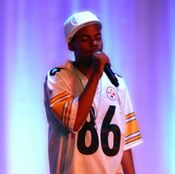
The first non-Japanese singer of enka was Sarbjit Singh Chadha from India. His first enka album was released in 1975 and became a success in Japan, selling 150,000 copies. He went back to India a few years later, but returned to Japan in 2008.[51]
In 2002, Yolanda Tasico became the first Filipina enka singer of the Philippines was going to Japan with his debut single are "Shiawase ni Naroo", "Nagai Aida", and many others.
In the United States, enka remains popular among a section of the (typically older) Japanese-American population, and enka has many fans among non-Japanese. There are some enka orchestras and performers active in the U.S., such as the San Jose Chidori Band, which occasionally performs at O-Bon festivals in the summer. In 2008, Jero became the first black enka singer with his debut single "UmiYuki" (海雪, lit. "Sea Snow") to have debuted at #4, wearing hip hop street attire.[8]
Enka artists
Enka artists include:
|
|
See also
- Teuroteu
- Kayōkyoku
Footnotes
References
- ↑ Christine Reiko Yano. Tears of Longing: Nostalgia and the Nation in Japanese Popular Song. Google Books. via Harvard Univ Asia Center. 2003. 42. ISBN 9780674012769
- ↑ 2.0 2.1 2.2 (Japanese) "The day that enka singer Hachiro Kasuga died". Nippon Television. 2008-10-22. http://www.ntv.co.jp/omoii-tv/today/081022.html. Retrieved 2009-02-09.
- ↑ 3.0 3.1 3.2 3.3 3.4 (Japanese) "Music and Contemporary Society". JASRAC contribution course in Keio University. 2002-10-21. http://www.flet.keio.ac.jp/kifu/jasrac/class/20021021.html. Retrieved 2009-01-18.
- ↑ (Japanese) "佐世保で生まれた日本初のワルツ「美しき天然」 ~その1~". Kyushu Railway Company. June 1997. http://www.atkyushu.com/InfoApp?LISTID=202&SCD=m199706. Retrieved 2009-02-07.
- ↑ (Japanese) "Kōjō no tsuki". Hokkaido University. http://www.cat.hokudai.ac.jp/osawa/member/ujima/butai/song1.bak. Retrieved 2009-02-23.
- ↑ (Japanese) "Yonanuki Onkai". Japan Arts Council. http://www2.ntj.jac.go.jp/dglib/edc8/nattoku/nippon/rroin/yonanuki.html. Retrieved 2009-02-23.
- ↑ 7.0 7.1 "'Enka' still strikes nostalgic nerve". The Japan Times. 2008-11-18. http://search.japantimes.co.jp/cgi-bin/nn20081118i1.html. Retrieved 2009-02-01.
- ↑ 8.0 8.1 "A Far Cry From Home". The Washington Post. 2008-05-28. http://www.washingtonpost.com/wp-dyn/content/article/2008/05/27/AR2008052703079_pf.html. Retrieved 2009-05-05.
- ↑ 9.0 9.1 (Japanese) "第6部・演歌巡礼<2>前川清 べたつかぬ距離感で歌う". Nishinippon Shimbun. 2006-12-13. http://www.nishinippon.co.jp/nnp/culture/kayou/20061213/20061213_001.shtml. Retrieved 2009-05-05.
- ↑ (Japanese) "松岡正剛の千夜千冊『J-POP進化論』佐藤良明". Matsuoka Seigo no Senya Sensatsu. 2000-12-28. http://www.isis.ne.jp/mnn/senya/senya0201.html. Retrieved 2010-04-23.
- ↑ 11.0 11.1 (Japanese) "俗にいう演歌の「こぶし」って一体ナニ?". R25.jp. 2008-05-23. http://r25.jp/b/honshi/a/link_review_details/id/1122008052308. Retrieved 2009-04-11.
- ↑ (Japanese) "古賀政男生誕百年「はなまつりコンサート」". Yumi Aikawa Official Website. http://www.jade.dti.ne.jp/~onodera/kanagawa.html. Retrieved 2009-05-18.
- ↑ 13.0 13.1 13.2 13.3 (Japanese) "第6部・演歌巡礼<7>古賀政男 日本的歌唱を熟知し作曲". Nishinippon Shimbun. 2006-12-19. http://www.nishinippon.co.jp/nnp/culture/kayou/20061219/20061219_001.shtml. Retrieved 2009-02-02.
- ↑ Roberson, James E. and Suzuki, Nobue. Men and Masculinities in Contemporary Japan. Google Books. via Routledge. 2003. 78. ISBN 9780415244466
- ↑ (Japanese) "世界は演歌に満ちている". Masayuki Tamaki Official Website. 2005-12-12. http://www.tamakimasayuki.com/musica/bn_53.htm. Retrieved 2009-02-01.
- ↑ (Japanese) "明治の声の文化". University of Tokyo. http://www.um.u-tokyo.ac.jp/publish_db/1999news/04/406/0406.html. Retrieved 2009-02-19.
- ↑ Lesley Downer. Madame Sadayakko: The Geisha Who Bewitched the West. Google Books. via Gotham. 2004. P-53. ISBN 9781592400508
- ↑ (Japanese) "第4回松尾芸能賞受賞者一覧". Matsuo Entertainment Development Foundation. http://www.rosenet.ne.jp/~matsuo-e/prize_4.html. Retrieved 2009-02-23.
- ↑ (Japanese) "日本の伝統・大道芸は妙技だ。街に復活せよ! =東京・浅草(下)". livedoor. 2007-08-11. http://news.livedoor.com/article/detail/3265500/. Retrieved 2009-02-21.
- ↑ "Street spirits plug in and out". The Japan Times. 2006-09-29. http://search.japantimes.co.jp/cgi-bin/fm20060929a1.html. Retrieved 2009-02-08.
- ↑ (Japanese) Kiyomaro Kikuchi (2006-03-23). "昭和流行歌の幕開け《波浮の港》". JANJAN. http://www.news.janjan.jp/column/0603/0603220226/1.php. Retrieved 2009-01-16.
- ↑ (Japanese) Kikuchi, Kiyomaro (2006-08-31). "異色歌手の登場:岡晴夫と田端義夫". JANJAN. http://www.news.janjan.jp/column/0608/0608300310/1.php. Retrieved 2009-05-16.
- ↑ "Jazz & Standard Complete Collection 1955-66". Amazon.com. http://www.amazon.com/Jazz-Standard-Complete-Collection-1955-66/dp/B0009OLPF6. Retrieved 2009-02-09.
- ↑ (Japanese) "歌舞伎ソング・《お富さん》のブーム". JANJAN. 2007-02-15. http://www.news.janjan.jp/column/0702/0702130008/1.php. Retrieved 2009-02-09.
- ↑ (Japanese) "Hachiro Kasuga Profile". Aizubange, Fukushima. http://www.town.aizubange.fukushima.jp/Members/syoukoukankou/contents/guide/kankou/kasugalife.html. Retrieved 2009-02-12.
- ↑ (Japanese) "Deracine Ching-dong". Soul Flower Union Official Website. http://www.breast.co.jp/soulflower/library/disc/detail/sf-070.html. Retrieved 2009-05-06.
- ↑ 27.0 27.1 27.2 27.3 (Japanese) "船村徹さん、演歌を愛し歌い続けて50年". Sanspo. 2003-05-18. Archived from the original on 2003-06-22. http://web.archive.org/web/20030622011048/http://www.sanspo.com/geino/top/gt200305/gt2003051808.html. Retrieved 2009-05-06.
- ↑ (Japanese) "別れの一本杉は枯れず". HMV Japan. http://www.hmv.co.jp/product/detail.asp?sku=1228316. Retrieved 2009-03-02.
- ↑ 29.0 29.1 29.2 29.3 (Japanese) "Michiya Mihashi". goo. http://music.goo.ne.jp/artist/ARTLISD1147250/index.html. Retrieved 2009-02-09.
- ↑ "When we had heroes". The Japan Times. 2001-07-22. http://search.japantimes.co.jp/cgi-bin/fl20010722a1.html. Retrieved 2009-10-16.
- ↑ 31.0 31.1 (Japanese) "第6部・演歌巡礼<8>初代桃中軒雲右衛門 受け継がれゆく浪花節". Nishinippon Shimbun. 2006-12-20. http://www.nishinippon.co.jp/nnp/culture/kayou/20061220/20061220_001.shtml. Retrieved 2009-02-02.
- ↑ (Japanese) "訃報・三波春夫さん". Nikkan Sports. 2001-04-15. http://www.nikkansports.com/jinji/2001/seikyo010415.html. Retrieved 2009-10-21.
- ↑ (Japanese) "Special 2. Japanese popular music (4)". Toshiba. November 2006. http://elekitel.jp/elekitel/special/2006/13/sp_02_d.htm. Retrieved 2009-05-15.
- ↑ (Japanese) "Toru Funamura". Columbia Music Entertainment. http://www.columbia-songs.co.jp/feature/02/funamura.html. Retrieved 2009-05-05.
- ↑ (Japanese) "12th Kōhaku Uta Gassen". Nikkan Sports. http://www.nikkansports.com/news2/entert2/2001kouhaku/history-12.html. Retrieved 2009-05-15.
- ↑ (Japanese) "7th Japan Record Award". Japan Composer's Association. http://www.jacompa.or.jp/rekishi/d1965.htm. Retrieved 2009-02-12.
- ↑ (Japanese) "訃報・青江三奈さん". Nikkan Sports. 2000-07-04. http://www.nikkansports.com/jinji/2000/seikyo000704.html. Retrieved 2009-09-14.
- ↑ (Japanese) "Minatomachi Blues". Japan Dredging Reclamation Engineering Association. September 2008. http://www.umeshunkyo.or.jp/204/263/data.html. Retrieved 2009-10-02.
- ↑ (Japanese) "オリコンのアルバム1位が千作品に 最多はユーミン". Asahi Shimbun. 2007-09-19. http://www.asahi.com/komimi/TKY200709190117.html. Retrieved 2009-01-27.
- ↑ (Japanese) "Keiko Fuji". Tsutaya. http://www.tsutaya.co.jp/item/artist/view_a_A006096.html. Retrieved 2009-05-06.
- ↑ (Japanese) "ランキング特集『オリコン首位獲得シングル1000曲(1968~2007)』". Oricon. 2007-02-21. http://www.oricon.co.jp/music/special/070221_01.html. Retrieved 2009-05-04.
- ↑ (Japanese) "Midaregami". Oricon. http://www.oricon.co.jp/music/release/d/32022/2/. Retrieved 2009-05-16.
- ↑ (Japanese) "Yoshimi Tendo". Nikkan Sports. 2004-12-26. http://www.nikkansports.com/ns/entertainment/interview/2004/sun041226.html. Retrieved 2009-05-21.
- ↑ (Japanese) "才色兼備の声優シンガーはオリコン2位!アニメ界を牽引する水樹奈々を直撃!". 2008-12-10. http://trendy.nikkeibp.co.jp/article/column/20081203/1021527/. Retrieved 2009-02-16.
- ↑ (Japanese) "運命的な出会いから生まれたデビュー曲". Nikkei Business Publications. 2008-08-11. http://trendy.nikkeibp.co.jp/article/special/20080807/1017494/?ST=yahoo_headlines&P=2. Retrieved 2009-05-05.
- ↑ (Japanese) "五木ひろしの新曲「高瀬舟」 オリコン初登場9位". Yomiuri Shimbun. 2006-05-11. http://www.yomiuri.co.jp/entertainment/music/news/20060511et01.htm. Retrieved 2009-05-04.
- ↑ "Bleach's, Major's Opening Singles Debut at #2, #10". Anime News Network. 2009-01-25. http://www.animenewsnetwork.com/news/2009-01-25/bleach-9th-major-5th-singles-debut-at-no.2-no.10. Retrieved 2009-05-06.
- ↑ 48.0 48.1 (Japanese) "坂本冬美、中村あゆみが作詞・作曲の新曲「アジアの海賊」発売". Yomiuri Shimbun. 2009-01-22. http://www.yomiuri.co.jp/entertainment/music/news/20090122et01.htm. Retrieved 2010-01-07.
- ↑ (Japanese) "北島三郎「73歳3か月」で最年長TOP10入り、19年ぶりに歴代記録抜く". Oricon. 2010-01-12. http://www.oricon.co.jp/news/rankmusic/72343/full/. Retrieved 2010-01-12.
- ↑ (Japanese) "『金スマ』効果! 坂本冬美のシングルが49週目で21年ぶりTOP10入り". Oricon. 2010-03-23. http://www.oricon.co.jp/news/rankmusic/74558/full/. Retrieved 2010-03-23.
- ↑ "Unsung Indian, this Singh is king in Japan". DNA India. October 8, 2008. http://www.dnaindia.com/report.asp?newsid=1196400. Retrieved 2009-02-09.
Further reading
Yano, Christine R. Tears of Longing: Nostalgia and the Nation in Japanese Popular Song. Harvard University Asia Center: 2003.
External links
- Barbara's Enka Site including introductions to artist and album reviews
- Enka – Song of sweet resignation three page introduction
- Enka: Suffering and Nostalgia for an Imagined Past A nice introduction to enka, which also analyzes its lasting popularity
- Jero: Japan's first black Enka singer
- Jero: Japan's First African-American Enka Singer - Article - Japan America Society of Greater Philadelphia